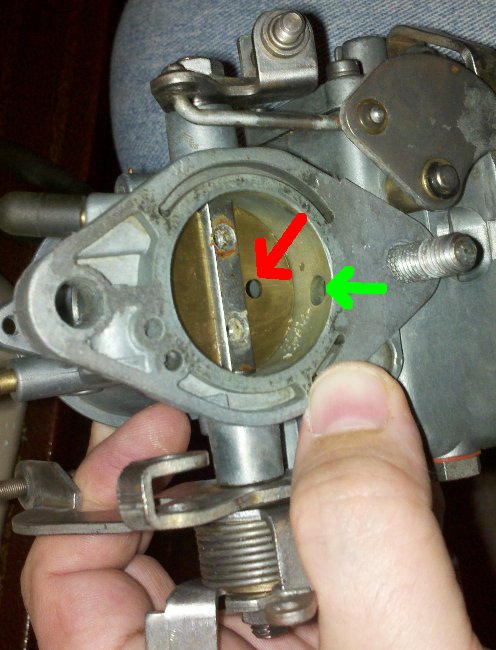As I talked about in the last entry, my struggles with my 34PICT-4 carburetor continued this spring, even after I fixed the fuel pressure. People had bugged me about it; I'd ignored it at first, but then I figured it couldn't hurt. I bought the gauge, tested the pressure, modified the configuration so that the pressure was reasonably correct, it still had the same problems. Humph.
I again spent a bunch of time digging around on thesamba.com. I'd encountered a few posts of people talking about putting a rivet in the hole in their throttle plate, or even soldering it shut. That seemed like a bad idea to me, but I at least tried to find the posts.
I found this post on holes in the throttle plates that gave me the idea that different sized holes would match to different other parts. Another evening of banging around and I finally found this post by carburetor expert keifernet which explicitly lists the diameter of the holes in the throttle plate. In case this URL ceases to work someday, I'm quoting the post here:
The DVDA is approx 5/32" and SVDA is 1/8". Hard to believe that difference does anything but trust me... it makes a big difference in the way the carb runs/tunes when your using a DVDA flange # German carb meant to be timed at 5 ATDC with an SVDA timed at 7.5 or an 009 timed at 10 BTDC. I find the pop rivet easier than taking the plate out and soldering the hole shut, grinding it flush and re drilling it but that's a personal choice. It can also be "undone" in a matter of minutes if someone wants to go back to a DVDA and does not alter the carb in any other way.By the way, SVDA means a "Single Vacuum Dual Advance" distributor; one that has centrifugal timing advance and vacuum advance (but not a vacuum retard). DVDA means a "Dual Vacuum Dual Advance"; a distributor with centrifugal advance (I think), please vacuum advance and vacumm retard.
Here's how this all works. Here's a picture of the business end of my
34PICT-4 carburator.

This is the end that bolts to the intake
manifold flange; the brass-colored circle in the middle is the
throttle plate. When you push down on the accelerator pedal, it opens
and allows lots of air and fuel through to make the engine run fast.
When you let the pedal up, it closes, as shown here.
The 34PICT series carburetors is unusual in how its idle circuit works. The carburetor idles with the throttle plate completely closed. There is a "bypass drilling" that goes from above the throttle plate, through the body of the carburetor, and then exits back into the carburetor throat just below the throttle plate, indicated by the green arrow. Inside the bypass is where fuel is added to the air for idling. Some air also goes through the throttle plate through the hole, indicated by the red arrow.
Although the idle mixture is controlled by adjustments on the carburetor, the base mixture (and the mixture ranges that are possible) depend on the balance betwen the amount of air flowing through the hole in the throttle plate and the amount if air/fuel coming through the bypass. The correct mixture at idle is different depending on what the idle ignition timing is, and that in turn is different between the SVDA and the DVDA distributors.
So having found the above posts, I measured the hole in the throttle plate in my 34PICT-4--and it was slightly larger than 5/32". This is not surprising; the 34PICT-4 was originally sold with a DVDA distributor, but I'm using a SVDA distributor (it's simpler and you can time it statically). So my throttle plate/distributor combination was wrong which is why I was having so much trouble. It explained why my 34PICT-3 carb worked Ok (it had the smaller hole throttle plate). It also explained two different 34PICT-4 carburetor bodies had the same problem (I used the same throttle plate both times).
I didn't mess around with rivets or solder--I just took the throttle plate out of my other carburetors with the smaller hole, put it in the 34PICT-4...and IT WORKED! Holy crap! A single change, of what seems to be a very small thing, and it ran like a totally different engine. The idle still wanders a tiny bit, but not badly, and I can tune the carb properly with the adjusting screws. Whoo-hoo!